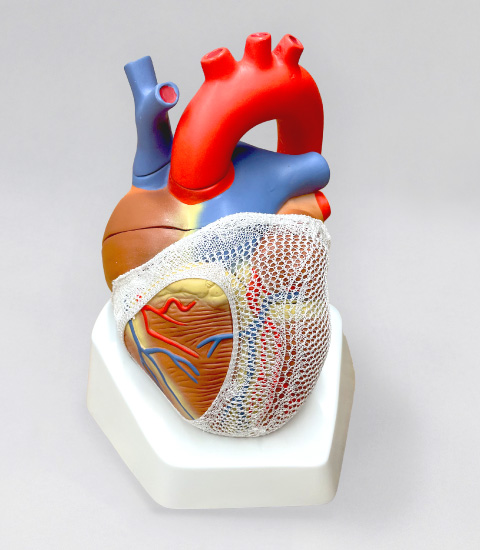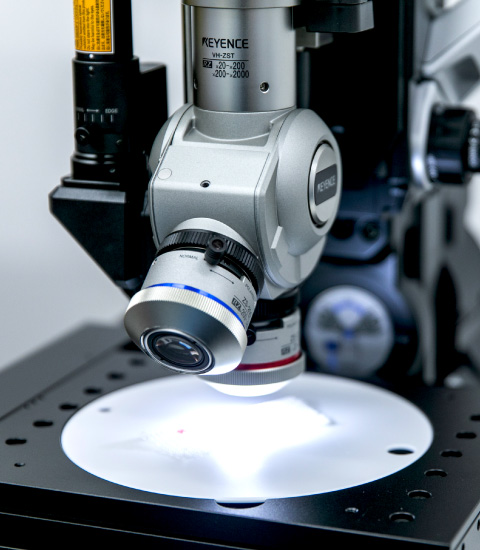OUTLINE
Cardiac Assist Net FAB
Background
Research Background
In the treatment of heart failure
The Way to Solve the Biggest Challengestowards (a destination)

Despite treatment with a variety of therapies, the number of patients with severe heart failure is rapidly increasing. The cost of medical care has become a major burden on the healthcare economy, and there is an urgent need to develop new, inexpensive, and widely applicable treatment methods.
In the past, Acorn CorCap, a cardiac support therapy that covers the heart with a mesh-like bag to prevent cardiac dilation (cardiac remodeling phenomenon), obtained CE Mark and was actually used for treatment in Europe. In patients with severe heart failure, progressive cardiac dilation worsens heart failure, so it was hoped that this treatment would work to reduce the dilation (cardiac remodeling).
However, the size of the net had to be adjusted intraoperatively by the surgeon to match the six standard sizes to the size of the individual patient's heart. In addition, since both ventricles were compressed with equal force, if enough pressure was applied to the left ventricle, the right ventricle would be overcompressed, resulting in right ventricular diastolic dysfunction and reduced cardiac output. The product was not approved in the U.S. due to a lack of evidence of effectiveness in terms of life expectancy.

Improved on past shortcomings.
New cardiac assist netDevelopment of

The Principal Investigators of this project were commissioned by the Ministry of Economy, Trade and Industry (METI) to conduct a three-year project to support the development and improvement of problem-solving medical devices, starting in 2011.
The "Cardiac Assist Net (Taylor Made Method Right Ventricular Restraint Reducing Cardiac Shape Correcting Net)" has been developed to solve the problems of past cardiac supportive treatments, such as "no need for intraoperative adjustments" and "no obstacle to right ventricular dilatation.
As a result, the following results have been achieved
(1) Establishment of a method for creating 3D heart models from cardiac images of patients with heart failure.
(2) Development of heart assist net pattern making program for computerized knitting machines manufactured by SHIMA SEIKI
(iii) Prototype of a cardiac assist net and verification of the safety and efficacy of the cardiac assist net in a large animal model of chronic heart failure.
(iv) In 2019-2021, three multicenter clinical studies (First in Human) were conducted in accordance with the Clinical Research Act, which showed significant improvement in motor performance.
(5) Based on the results of the clinical study, a protocol consultation was conducted by PMDA in 2021, and a clinical trial plan for an exploratory investigator-initiated clinical trial was developed. The exploratory investigator-initiated clinical trial is scheduled to start in the first half of 2022.
6) Experimental evaluation of the efficacy and safety of a right ventricular constraint-reducing cardiac shape correcting net in a large animal model of chronic heart failure.
(7) Safety testing under GLP standards
8) PMDA Strategic Consultation

Overview
Research Overview
in patients with dilated cardiomyopathy.
Cardiac Assist Net Clinical POC
This clinical study is a multicenter, first-in-human (FIH) clinical study mainly evaluating the safety of the "Taylor Made Right Ventricular Restraint Reducing Cardiac Shape Correction Net," which was developed to prevent the progression of cardiac remodeling in patients with dilated dilated left ventricular myocardiopathy.
jRCTs042180025: Clinical trial of a tailor-made heart shape correction net for dilated cardiomyopathy.
The primary endpoint is to evaluate the safety of the study device, but efficacy in terms of improvement of cardiac function, prevention of left ventricular remodeling, and improvement of quality of life will also be evaluated in an exploratory manner as secondary endpoints.
01Main selection criteria
| Target Patients (Target Diseases) | Patients with dilated cardiomyopathy presenting with heart failure and NYHA classification III or IV whose symptoms do not improve with current treatment (excluding patients who are planned for concomitant surgery such as mitral valve replacement, mitral valve plication, or tricuspid valve plication) |
|---|---|
| selection criteria |
Patients who meet all of the following criteria will be selected as subjects Patients who have given written consent to participate in the study of their own free will Patients who are at least 20 years old and less than 75 years old at the time of consent Patients with persistent heart failure symptoms despite at least 3 months of optimal medical therapy for heart failure (ACE inhibitors, ARBs, diuretics, beta-blockers, oral inotropic agents, etc.) and no improvement with current therapy. Patients with NYHA Classification III or IV and Level 4 to 7 of INTERMACS Profile Patients with LVEDD≥60mm or LVEDDi≥30mm/m2 on echocardiography Patients with LVEF ≤ 351 TP3T on echocardiography or RI Patients with RVEDVi ≤ 170 mL/m2 on MRI or contrast CT scan Patients who are willing to undergo follow-up examinations and observations and who are able to visit the implementing institution. |
| exclusion criteria |
Patients who meet any of the following criteria should be excluded Patients with excessive cardiac enlargement (LVEDD > 85 mm) Patients with severely depressed left ventricular function (LVEF <10%) Patients with a history of previous cardiac surgery (except for patients with pericardial effusion and minimal pericardial adhesion, and excluding ICD and pacemaker implantation surgery) Patients scheduled for other cardiac surgery Patients with a history of CABG or scheduled for CABG Patients or candidates for PCI or transmyocardial laser revascularization within 3 months prior to surgery Patients undergoing IABP Patients with NYHA Classification IV who are candidates for assisted cardiac device and heart transplantation. Patients who have undergone biventricular paging (CRT (including ICD and pacemaker implantation surgery) or are scheduled to undergo CRT within 3 months prior to surgery. Patients expected to live less than 1 year ・Last stage heart failure patients with increased surgical risk |
02research methods
- Patients at each of the five collaborating institutions (five universities) who have given their consent will undergo cardiac imaging and catheterization to create a tailor-made cardiac shape correction net, which will be placed under general anesthesia.
- Cardiac function, cardiac remodeling effects, quality of life, and exercise tolerance will be evaluated at 6 months to assess adverse events and efficacy.
- Nagoya University will be in charge of the Clinical Trials Secretariat.

CONTACT
Contact Us
About the Cardiac Support Net treatment and,
Clinical trials, etc.
Please feel free to contact us for any inquiries.

